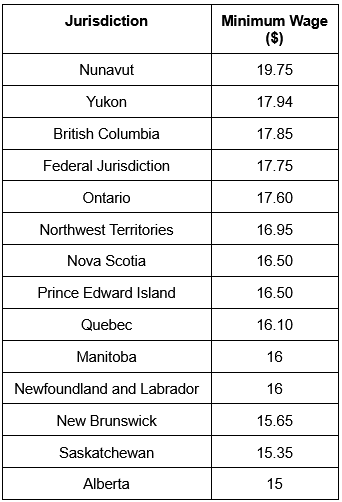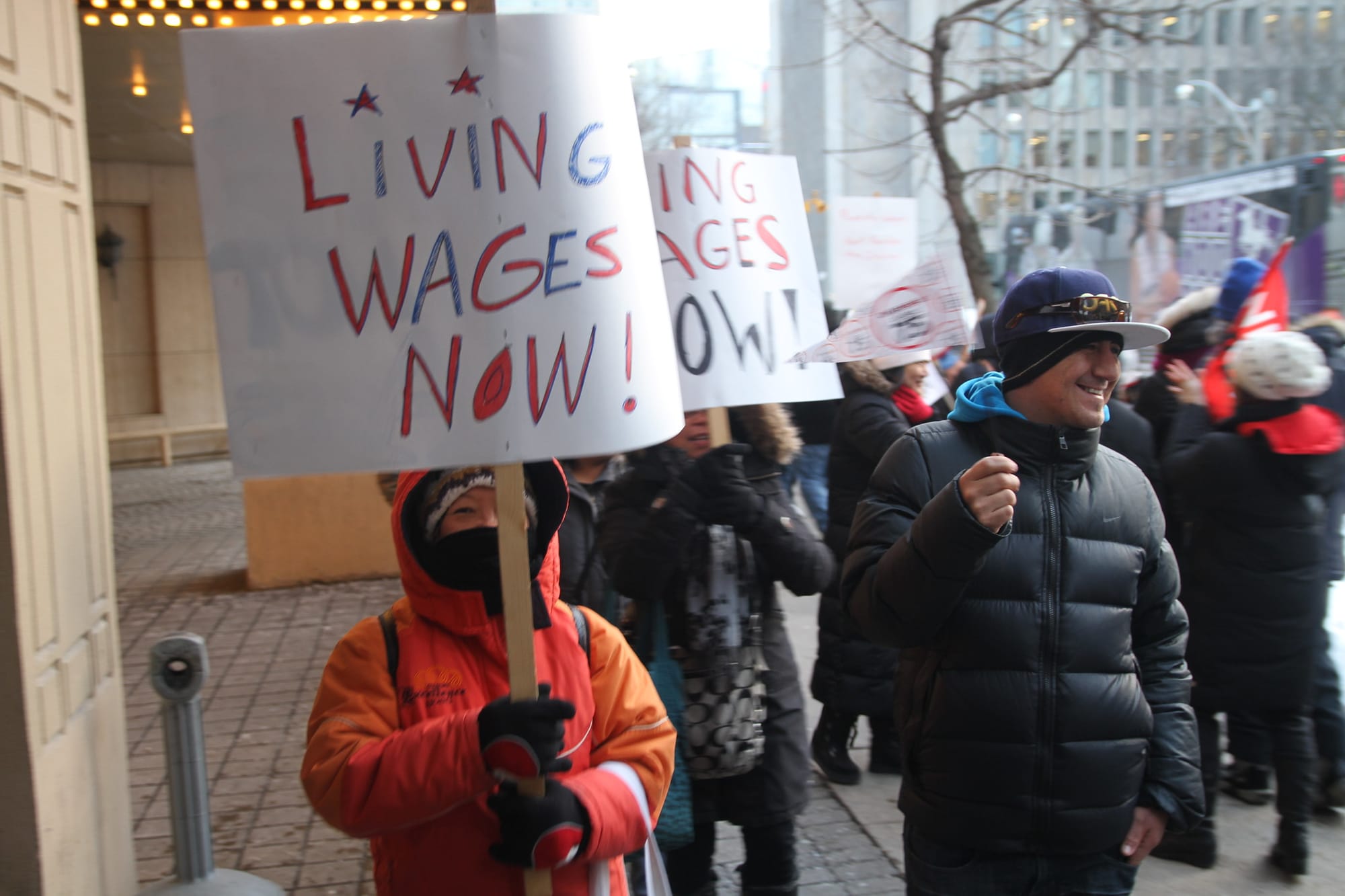
On October 1, low-wage workers in Ontario, Manitoba, Saskatchewan, Nova Scotia and Prince Edward Island got a much-needed raise when the governments in these provinces increased their minimum wages.
As workers across the country continue to struggle with a cost-of-living crisis, unaffordable housing and inflated food prices, a boost to minimum pay rates is welcomed, though insufficient.
Other provinces, territories and the federal government adjusted their minimum wage rates earlier in the year.
As of now, this is how the minimum wage stacks up across Canada’s 14 jurisdictions.

Nunavut and Yukon continue to lead with their nominal minimum wage rates of $19.75 and $17.94, respectively, in part reflecting the high costs of food and shelter in the North.
Among the provinces, British Columbia continues to have the highest minimum wage at $17.85 per hour, despite Ontario increasing its rate to $17.60 on October 1.
As the most-populous Canadian province, Ontario has the highest concentration of workers earning the minimum wage. Roughly 800,000 workers are expected to get a boost from last week’s increase, not including all the other workers earning above the minimum wage who typically see raises as a spillover effect.

Manitoba and Saskatchewan raised their rates to $16 and $15.35 per hour, respectively. While these Prairie provinces typically have lower levels of overall unemployment, their minimum wage rates are on the lower side, particularly in Saskatchewan.
Nova Scotia and P.E.I., the two other provinces that hiked their minimum wages last week, have improved their rates from several years ago, now both sitting at $16.50 per hour.
As important as these increases are, it remains the case that in no Canadian jurisdiction is the minimum wage a living wage. In many cases, it’s not even close.
In regions throughout Ontario, the gap between the minimum wage and a living wage sufficient to support a worker and their family is often sizable. The Ontario Living Wage Network put the living wage for the Greater Toronto Area in 2024 at $26 per hour, for instance. In less expensive parts of the province, the gap was still considerable.
The Manitoba Federation of Labour characterized their province’s bump to $16 as inadequate. In an Instagram post, the labour federation wrote, “Most minimum wage workers are women and adults. And the majority of them work for big companies that employee [sic] 100 employees or more. These are companies that can afford to pay workers more. It’s time for a minimum wage that’s enough for workers to afford groceries and rent.”
There are significant gaps between minimum wage rates and a living wage in the Atlantic provinces as well. According to recent calculations by the Canadian Centre for Policy Alternatives, the living wage rates for Nova Scotia, Newfoundland and Labrador, and P.E.I. are $27.60, $25.31, and $22.77, respectively, a far cry from those provinces’ minimum wages. In Nova Scotia’s case, the gap is an astonishing $11.90 per hour.
Alberta, the notable laggard among Canadian jurisdictions, has not raised its minimum wage since 2018, when the NDP government brought it to $15 per hour, the highest in Canada at the time.
With Saskatchewan’s raise last week, Alberta now has the lowest minimum wage in the country, despite a nearly 25 per cent increase in the Consumer Price Index (CPI) since October 2018. The Alberta Federation of Labour is calling for a $20 minimum wage.
Alberta is also the only Canadian jurisdiction that doesn’t index its minimum wage. Every other jurisdiction in Canada adjusts its minimum wage annually, though many only began doing so after the start of the pandemic. This meant that workers in some jurisdictions waited years for wage increases. Progressive Conservative governments in Ontario during the 1990s and early 2000s, for example, infamously froze the minimum wage at $6.85 for eight years.
After the post-pandemic inflationary shock, the need to protect low-wage workers’ purchasing power was readily apparent.
In all those jurisdictions where the minimum wage is now automatically adjusted yearly, formulas for indexing vary slightly. In most, the minimum wage is pegged to provincial inflation, as measured by the CPI. In some cases, governments use a more detailed formula or a consultative process to set their minimum wage.
In the Northwest Territories and Nunavut, for example, each territory’s minimum wage is adjusted using a formula that, in addition to inflation, takes account of overall wage growth. In other words, when non-minimum wage earning workers in these two territories grow their wages, the benefits also spill over to those earning the minimum wage. Saskatchewan uses a similar practice.
In P.E.I., annual Minimum Wage Orders are issued after considering increases in the cost of living, updated measures of poverty and general economic conditions. So while P.E.I. employs indexation, it is also embedded in a consultative process that allows for some political influence from employers and labour.
Although indexation is important, it also has its drawbacks. Adjustments are made using previous years’ inflation figures, so that abrupt price increases, such as those during the pandemic, have no immediate effect on minimum wage rates. Low-wage workers must bear the costs of inflation upfront and wait until the following year for relief.
In addition, indexation can also turn minimum wage setting into a technocratic exercise, replacing struggles over the cost of living with a pre-determined formula that effectively prevents the lowest paid workers from making real wage gains by increasing their pay faster than the rate of inflation.
Minimum wages, therefore, remain inadequate and problematic across Canada.
The insufficiency of the minimum wage is a direct consequence of its gendered history. Originally envisaged largely as a means to protect the normative breadwinning male worker from the labour competition of women and children, minimum wage rates were invariably set low. The imagined minimum wage worker of the time was the dependent of a man whose responsibility it was to earn a family-supporting income. Minimum wage workers, the logic went, earned ‘secondary’ income and therefore could justifiably be paid substandard rates.
Though this gendered division of labour was normative, it was never universal. That hasn’t, however, prevented this legacy from continuing to distort our contemporary political economy. Think of the frequent refrain from employers that minimum wage earners are primarily teenagers or others not living on their own, despite evidence showing that a growing number of low-wage workers are in fact supporting dependants. Research from the Parkland Institute in Alberta, for example, found that in 2019-20, 74 per cent of minimum wage earners were in permanent jobs, 73 per cent were not teenagers, 41 per cent were parents and 34 per cent were the heads of their households.
In some provinces, such as Ontario and Alberta, employers are still permitted to pay a lower minimum wage to students. The student minimum wage in Ontario increased to $16.60 per hour on October 1. In Alberta, it remains stuck at $13 per hour. Assigning lower rates to students or other workers undermines the universality of the minimum wage.
As well, two provincial governments still engage in the backward practice of setting specific minimum overtime rates.
In all Canadian jurisdictions, employers are required to pay a premium for hours worked above a weekly threshold: typically 40 hours, though in some provinces it is 44 or 48 hours. Typically, the standard is a rate one and a half times the worker’s regular wage. However, New Brunswick and Newfoundland and Labrador both set “minimum overtime rates” based on their respective provincial minimum wages rather than the worker’s regular wage. Currently, these minimum overtime rates are $23.48 in New Brunswick and $24 in Newfoundland and Labrador. Businesses who employ workers at higher rates can access overtime from them without paying any extra, if they so choose.
Despite the importance of recent bumps and annual indexation, minimum wage rates across Canada remain highly inadequate, leaving far too many workers struggling to get by.
Ultimately, the best palliative to low-wage work is unionization. If living wages are the goal, the surest path to get there is expanding access to collective bargaining.
Recent Class Struggle Issues
- September 29 | Canada Post’s Moment Of Reckoning May Finally Be Here
- September 22 | Unions Improve Social Well-Being Even For Non-Members
- September 15 | Air Canada Flight Attendants Overwhelmingly Reject Wage Proposal
- September 8 | Public Servants In British Columbia Are On Strike








